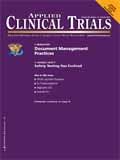Debate Grows Over Comparative Efficacy Trials
Applied Clinical Trials
UK officials stress importance of evaluating benefits of new therapies before approval.
To help ensure that the most beneficial and safest therapies reach patients and that limited healthcare resources are invested wisely, manufacturers should be forced to show how their drugs compare to existing treatments before a new approval is issued, according to a group of UK researchers.
"Numerous promising medicines have been developed," noted researchers at the London School of Economics and the European Observatory on Health Systems and Policies. "With this success comes an equally important additional need—to develop a systematic approach to evaluate the risks and benefits of these new therapies in the context of existing alternatives. An important initial step is to support a formal role for comparative efficacy evidence in drug licensing."
This position is supported increasingly by the European Medicines Agency (EMA) and European Commission, they wrote in an online article published by the British Medical Journal (BMJ) on September 6. The EMA has recommended randomized active-control trials (RaCTs) when a new drug might be associated with safety or inferiority concerns, but the authors of the BMJ article propose that non-inferiority be recommended for all conditions where alternative treatment options exist. This would help to address the current variability in availability of such evidence across therapeutic areas.
"It is clear that comparative efficacy assessment is not necessarily a panacea," they stated. "No particular study design alone is ideal for assessing comparative efficacy and there is the inherent challenge of ensuring studies adequately address the most relevant clinical and policy questions to support safe and effective use of new therapies."
Currently, direct comparisons with existing therapies are only required when use of a placebo is deemed unethical. This does not allow patients, clinicians, and other healthcare decision makers to determine whether a new drug is superior, equivalent, or inferior to its existing alternatives, and can result in the widespread use of potentially less efficacious and unsafe drugs, they warned.
The EMA has advocated that, when possible, pre-market studies should be undertaken to establish comparative efficacy and risk, but has yet to set comparative assessments as the standard for market approval. Requirements for comparative studies are made on a case-by-case basis, they pointed out.
The researchers estimate that comparative efficacy data are available for 50% to 70% of new molecular entities at the time of approval, but often only a fraction of evidence is accessible at the time of market authorization. A further challenge is that no particular type of study is ideal for assessing comparative efficacy.
"An important first step is to achieve open dialogue and agreement between the EMA, manufacturers, payers, and governments on the outstanding methodological questions and hurdles associated with comparative efficacy studies. An independent EMA advisory board could be established to lead such discussions and ultimately provide guidance on: what type of study design(s) can be accepted as fit for purpose for generating comparative efficacy evidence; standards for comparator selection and assessed endpoints; dosing schemes; sample size requirements to demonstrate the margin of superiority, equivalence or non-inferiority; and options to make the conduct of comparative studies more efficient," they stated.
A limitation of present regulatory systems, however, is the "suboptimal" publication of, and public access to, comparative information on the efficacy, effectiveness, and safety of new drugs. A lack of early comparative efficacy evidence can result in the widespread use of potentially less efficacious and unsafe drugs, as highlighted by the recent case of the diabetes drug rosiglitazone, according to the authors. The relative effect of rosiglitazone against pioglitazone emerged after years of widespread use, where rosiglitazone was shown to increase the risk of myocardial infarction and cardiovascular death, they explained.
Regulators must insist on submission of full data, including trial protocols and raw datasets, and adopt and enforce a policy to publicly share available data, they argued. Better data exchange may involve including protocols and datasets within trial registries, enhancing the quality and transparency of the European Public Assessment Reports, reporting comparative evidence in product labels and marketing materials, and by journals adopting similar data submission requirements. These efforts would help ensure that researchers have access to detailed enough data to allow independent re-analysis of trials and potentially contribute to improving post-market comparative effectiveness assessment, they wrote.
The lead author of the BMJ article is Corinna Sorenson, a research fellow at the LSE. —Philip Ward

Improving Relationships and Diversifying the Site Selection Process
April 17th 2025In this episode of the Applied Clinical Trials Podcast, Liz Beatty, co-founder and chief strategy officer, Inato, discusses a number of topics around site engagement including community-based sites, the role of technology in improving site/sponsor relationships, how increased operational costs are impacting the industry, and more.
Behind the Buzz: Why Clinical Research Leaders Flock to SCOPE Summit
February 7th 2025In this episode, we meet with Micah Lieberman, Executive Conference Director for SCOPE Summit (Summit for Clinical Ops Executives) at Cambridge Innovation Institute. We will dive deep into the critical role of collaboration within the clinical research ecosystem. How do we bring together diverse stakeholders—sponsors, CROs, clinical trial tech innovators, suppliers, patients, sites, advocacy organizations, investors, and non-profits—to share best practices in trial design, program planning, innovation, and clinical operations? We’ll explore why it’s vital for thought leaders to step beyond their own organizations and learn from others, exchanging ideas that drive advancements in clinical research. Additionally, we’ll discuss the pivotal role of scientific conferences like SCOPE Summit in fostering these essential connections and collaborations, helping shape the future of clinical trials. Join us as we uncover how collective wisdom and cross-industry partnerships are transforming the landscape of clinical research.